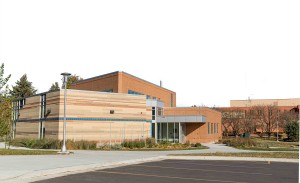The U.S. Green Building Council has awarded South Dakota State University’s American Indian Student Center with a LEED V4 Gold certification. Developed by the U.S. Green Building Council, Leadership in Energy and Environmental Design is the most widely used green building rating system in the world and an international symbol of excellence. Through design, construction and operations practices that improve environmental and human health, LEED-certified buildings are helping to make the world more sustainable.
The American Indian Student Center, which exceeded the minimum state requirement of LEED Silver status by 15 points, achieved LEED V4 Gold certification for implementing measurable strategies and solutions in all areas of sustainable construction including site development, water savings, energy efficiency, materials selection and indoor environmental quality.
The path to LEED Gold certification began with the initial site selection and development process for the American Indian Student Center. The selected site was located within the university ring road on land that was previously developed as a storage shed and research plot for the horticulture program. The storage shed that had been located on the site was removed in 1967 when Bailey Rotunda Hall was constructed, and the leftover turf area became known as Rotunda Green.
Attention was devoted to developing the brownfield site to maintain existing vegetation and enhance the open space surrounding the building. Eighty-seven percent (72,100 square feet) of the site is considered open space for enhanced landscaping and outdoor social space. The sedge meadow, regional vegetation and turf grasses surrounding the building were designed as low input pollinator habitat that enhances water resource conservation and campus aesthetics.Â
The AISC is also exemplary in the category of energy and atmosphere. The building demonstrates an energy-cost savings of 30% above industry standards and produces 11,360 kilowatt-hours of electricity per year with the salvaged 7kW photovoltaic system installed on the roof of the general classroom. The energy efficiency measures and renewable energy production are estimated to save $5,200 in annual energy costs.
“The photovoltaics installed on the building were donated by the electrical engineering and computer science department. The PV system reused existing materials, saved the project money, helped the building achieve LEED Gold certification and will produce renewable energy for decades. The collaboration illustrates how an integrated team approach benefits the university,†said Reed Leibel ’10, project manager with Facilities and Services.
In addition to energy performance, the AISC’s design focused on connections between interior and outdoor spaces through daylight and views. The project has earned an exemplary performance for daylight with more than 90% of regularly occupied spaces having access to functional daylight and views. In addition to enhancing the indoor environment, daylight harvesting strategies were implemented, which coordinate the electrical lighting levels with available daylight in the building. The integrated lighting strategy further enhances the energy performance of the building.
“Green buildings allow South Dakota State University to operate more sustainably and give students, faculty and staff a healthier, more comfortable space to work and live. Green building certification is proof that SDSU values sustainability and the quality of our built environment. We are dedicated to constructing and operating our buildings at the highest levels of sustainability,†said Jonathan Meendering, a project architect with Facilities and Services.






